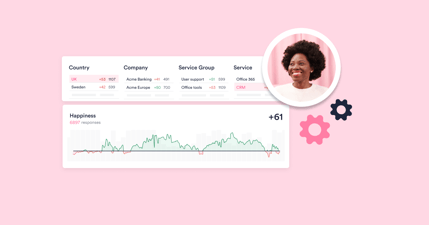As the name suggests, IT experience management (ITXM) is an experience management framework originally used to enhance IT service delivery and support. However, because of its people-centric rather than technology-centric nature, its core principles – measure, share, identify, and improve – can also be used in non-IT business functions such as human resources (HR), legal, security, facilities, and finance. Where it has the potential to drive better employee experiences and business outcomes both within the business function and across the organization.
Why ITXM works for other business functions
The four components of the ITXM Framework are all people-centric, meaning this systematic approach to experience management can be used in other business functions. In the same way that ITXM provides greater insights through experience data than traditional IT metrics, the framework can offer similar capabilities to other business functions. Allowing them to focus on employee productivity and satisfaction with the services and support they consume by:
- Measuring experiences and quantifying employee happiness and productivity in real-time
- Sharing the experience data to build trust and cooperation
- Identifying improvements from the collated experience data
- Improving what matters most through data-driven decisions.
It might seem odd that something called the IT Experience Management Framework has non-IT use cases. However, in the same way ITIL started life as the IT Infrastructure Library focused on IT service management (ITSM), the growth in enterprise service management strategy adoption has opened the door for ITXM to be shared with or extended to other business functions along with more traditional ITSM capabilities. Here are two examples.
-
Applying ITXM to HR
HR is a good business function to start with. After all, it was one of the earliest use cases for enterprise service management. Plus, it’s focused on ensuring employees can contribute as much as possible to the organization.
HR teams can use experience data to assess employees’ experiences with HR services, tools, and processes. The ITXM Framework provides a proactive feedback mechanism that allows HR leaders to identify and address employee issues. As with the use of ITXM in IT, it will enable people to better understand the impact of current HR capabilities on employee happiness and productivity. Such that data-driven HR strategies can be created based on empirical evidence rather than anecdotal feedback.
Given that HR usually owns the overall employee experience (for working within a company), HR-related examples of the insights ITXM and experience data can deliver to HR also include:
- Revealing and addressing employee issues such as lack of growth opportunities, unbalanced workloads, or inadequate resources.
- Predicting and addressing employee turnover issues by identifying patterns such as declining satisfaction scores.
- Assessing inclusivity and diversity experiences to adjust policies or training to foster a more inclusive environment.
- Better understanding remote worker needs related to work-life balance, communication and collaboration capabilities, and other areas.
- Providing insights into how organizational changes such as mergers, acquisitions, or restructuring affect the workforce.
The employees included in these examples could work anywhere, including HR. Additionally, other business functions might need to be involved in executing remedial action. For example, the finance team will likely need to allocate the budget for improvement initiatives.
-
Applying ITXM to finance operations
As with HR and IT, finance teams can use ITXM’s “identify” step to pinpoint areas where employees experience inefficiencies and issues with their finance interactions. Employing experience-based key performance indicators (KPIs) allows finance leadership to monitor and improve service quality in areas such as budget setting and expense payments, i.e. the finance team’s touchpoints with employees.
An example is data-driven budget allocation, where not only can finance leaders use experience data to improve the process, but it can also be used to inform workforce planning and budget allocations. If data indicates low employee morale or engagement in specific departments, budgets can be allocated to initiatives focusing on employee development, well-being programs, or new technology investments.
Given that “everything costs,” finance leaders can also use experience data to help other business functions to drive down operational costs because employee experience data can provide insights into productivity, innovation, and, ultimately, the company’s bottom line. A good example is lowering hiring and onboarding costs (which links to the HR turnover opportunity). By analyzing employee experience data, finance leaders can help HR teams identify “at-risk” employees early and reduce turnover (and the associated costs) through targeted retention strategies.
There are many potential business function use cases
Similar use cases for other business functions also apply. For example, the facilities team can apply ITXM to their service experiences and work with other business functions to improve employee experiences and productivity. For instance, in ensuring any homeworking barriers to employee productivity related to facilities are addressed. So, the benefits for business function leaders are twofold – they can leverage ITXM data to reduce friction in their capabilities and enhance their collaboration with other departments to improve employee experiences and business-wide productivity.
The human-centric experience management capabilities that started in IT equally apply to other business functions such as HR, finance, facilities, and legal. If you want to learn more about these opportunities and how to grasp them, get in touch to discuss your challenges and how experience management can help.




